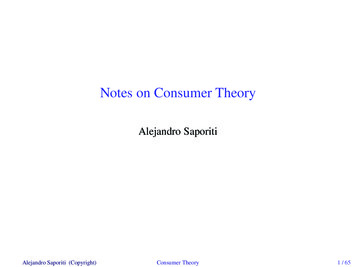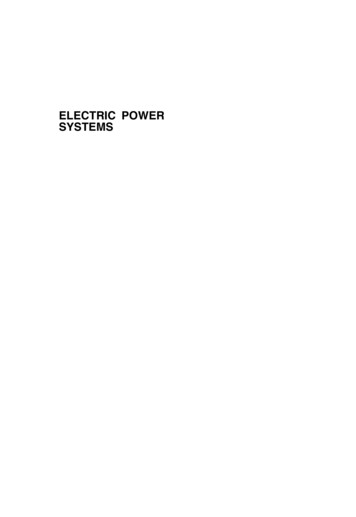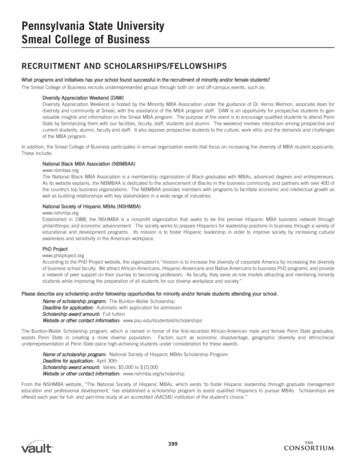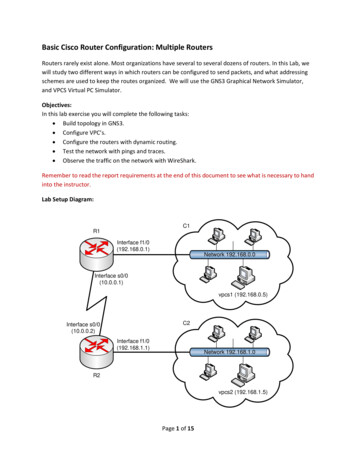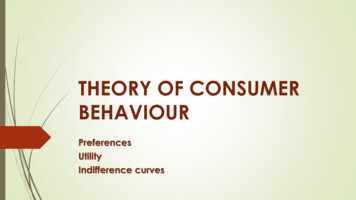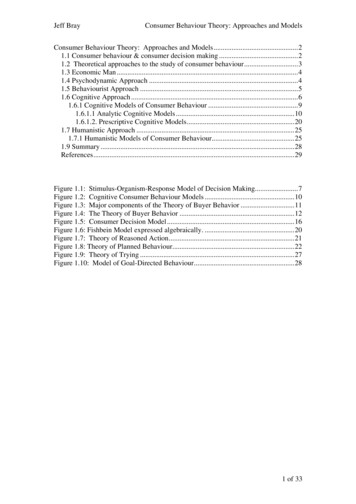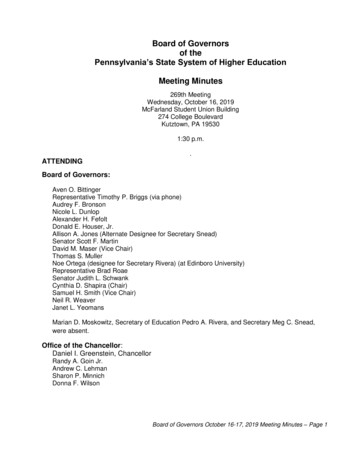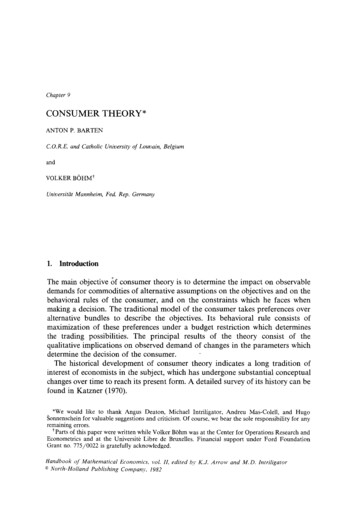
Transcription
Chapter 9CONSUMERTHEORY*ANTON P. B A R T E NC.O.R.E. and Catholic University of Louvain, BelgiumandVOLKER BC)HM Universiti t Mannheim, Fed. Rep. Germany1.IntroductionThe main objective 6f consumer theory is to determine the impact on observabledemands for commodities of alternative assumptions on the objectives and on thebehavioral rules of the consumer, and on the constraints which he faces whenmaking a decision. The traditional model of the consumer takes preferences overalternative bundles to describe the objectives. Its behavioral rule consists ofmaximization of these preferences under a budget restriction which determinesthe trading possibilities. The principal results of the theory consist of thequalitative implications on observed demand of changes in the parameters whichdetermine the decision of the consumer.The historical development of consumer theory indicates a long tradition ofinterest of economists in the subject, which has undergone substantial conceptualchanges over time to reach its present form. A detailed survey of its history can befound in Katzner (1970).*We would like to thank Angus Deaton, Michael Intriligator, Andreu Mas-Colell, and HugoSonnenschein for valuable suggestions and criticism. Of course, we bear the sole responsibility for anyremaining errors.* Parts of this paper were written while Volker B6hrn was at the Center for Operations Research andEconometrics and at the Universit6 Libre de Bruxelles. Financial support under Ford FoundationGrant no. 775/0022 is gratefully acknowledged.Handbook o f Mathematical Economics, voL II, edited by K.J. Arrow and M.D. Intriligator North-Holland Publishing Company, 1982
3822.A. P. Barten and V. BghmCommodities and pricesCommodities can be divided into goods and services. Each commodity is completely specified by its physical characteristics, its location, and date at which it isavailable. In studies of behavior under uncertainty an additional specification ofthe characteristics of a commodity relating to the state of nature occurring may beadded [see Arrow (1953) and Debreu (1959)], which leads to the description of acontingent commodity. With such an extensive definition of a commodity thetheory of the consumer subsumes all more specific theories of consumer choice oflocation and trade, of intertemporal choice over time, and of certain aspects ofthe theory of decisions under uncertainty. Formally these are equivalent. Thetraditional theory usually assumes that there exists a finite number of commodities implying that a finite specification of physical characteristics, location, etc.suffices for the problems studied. Quantities of each commodity are measured byreal numbers. A commodity bundle, i.e. a list of real numbers (Xh) , h 1 . ,indicating the quantity of each commodity, can be described therefore as ane-dimensional vector x ( x 1. xe) and as a point in g-dimensional Euclideanspace R e, the commodity space. Under perfect divisibility of all commodities anyreal number is possible as a quantity for each commodity so that any point of thecommodity space R e is a possible commodity bundle. The finite specification ofthe number of commodities excludes treatment of situations in which characteristics may *ary continuously. Such situations arise in a natural way, for example, inthe context of quality choice of commodities, and in the context of locationtheory when real distance on a surface is the appropriate criterion. As regards thetime specification of commodities, each model with an infinite time horizon,whether in discrete or continuous time, requires a larger commodity space. This isalso the case for models of uncertainty with sufficiently dispersed random events.These situations lead in a natural way to the study of infinite dimensionalcommodity spaces taken as vector spaces over the reals. Applications can befound in Gabszewicz (1968) and Bewley (1970, 1972), with an interpretationregarding time and uncertainty. Mas-Colell (1975) contains an analysis of qualitydifferentiation. As far as the theory of the consumer is concerned many of theusual results of the traditional theory in a finite dimensional commodity spacecan be extended to the infinite dimensional case. This survey restricts itself to thefinite dimensional case.The price Ph of a commodity h, h l . , is a real number which is theamount paid in exchange for one unit of the commodity. With the specification oflocation and date the theory usually assumes the general convention that theprices of all commodities are those quoted now on the floor of the exchange fordelivery at different locations and at different dates. It is clear that otherconventions or constructions are possible and meaningful. A price system or a
Ch. 9: Consumer Theory383price vector p (Pl . Pc) can thus be represented by a point in Euclidean spaceR e. The value of a commodity bundle given a price vector p is ] l phxh p . x .3.ConsumersSome bundles of the commodity space are excluded as consumption possibilitiesfor a consumer by physical or logical restrictions. The set of all consumptionbundles which are possible is called the consumption set. This is a non-emptysubset of the commodity space, denoted by X. Traditionally, inputs in consumption are described by positive quantities and outputs b y negative quantities. Thisimphes, in particular, that all labor components of a consumption bundle x arenon-positive. One usually assumes that the consumption set X is closed, convex,and bounded below, the lower bound being justified by finite constraints on theamount of labor a consumer is able to perform. A consumer must choose abundle from his consumption set in order to exist.Given the sign convention on inputs and outputs and a price vector p, the valuep . x of a bundle x E X indicates the net outlay, i.e. expenses minus receipts,associated with the bundle x. Since the consumer is considered to trade in amarket, his choices are further restricted by the fact that the value of hisconsumption should not exceed his initial wealth (or income). This m a y be givento him in the form of a fixed non-negative number w. He may also own a fixedvector of initial resources 0, a vector of the commodity space R e. In the latter caseIris initial wealth given a price vector p is defined as w p . o. The set of possibleconsumption bundles whose value does not exceed the initial wealth of theconsumer is called the budget set and is defined byfi(p,w) {x Xlp.x w}.(3.1)The ultimate decision of a consumer to choose a bundle from the consumptionset depends on his tastes and desires. These are represented by his preferencerelation which is a binary relation on X. For any two bundles x and y,x X , y X , x y means that x is at least as good as y. Given the preferences theconsumer chooses a most preferred bundle in his budget set as his demand. This isdefined ascp(p,w) (xEfl(p,w)lx'Efl(p,w)impliesx x'ornotx' x } .(3.2)Much of consumer theory, in particular the earlier contributions, describeconsumer behavior as one of utility maximization rather than of preferencemaximization. Historically there has been a long debate whether the well-being of
384A. P. Barten and V. B6hman individual can be measured by some real valued function. The relationshipbetween these two approaches has been studied extensively after the first rigorousaxiomatic introduction of the concept of a preference relation by Frisch (1926). Ithas been shown that the notion of the preference relation is the more basicconcept of consumer theory, which is therefore taken as the starting point of anyanalysis of consumer behavior. The relationship to the concept of a utilityfunction, however, as a convenient device or as an equivalent approach todescribe consumer behavior, constitutes a major element of the foundations ofconsumer theory. The following analysis therefore is divided basically into twoparts. The first part, Sections 4-9, deals with the axiomatic foundations ofpreference theory and utility theory and with the existence and basic continuityresults of consumer demand. The second part, Sections 10-15, presents the moreclassical results of demand theory mainly in the context of differentiable demandfunctions.4.PreferencesAmong alternative commodity bundles in the consumption set, the consumer isassumed to have preferences represented by a binary relation on X. For twobundles x and y in X the statement x y is read as " x is at least as good as y".Three basic axioms are usually imposed on the preference relation which are oftentaken as a definition of a rational consumer.Axiom 1 (Reflexivity)For all x E X , x x, i.e. any bundle is as good as itself.Axiom 2 (Transitivity)For any three bundles x, y, z in X such that x y and y z it is true that x z.Axiom 3 (Completeness)For any two bundles x and y in X, x y or y x.A preference relation which satisfies these three axioms is a completepreordering on X and will be called a preference order. Two other relations can bederived immediately from a preference order. These are the relation of strictpreference and the relation of indifference .Definition 4.1A bundle x is said to be strictly preferred to a bundle y, i.e. x y if and only ifx y and not y x.
Ch. 9." Consumer Theory385Definition 4.2A bundle x is said to be indifferent to a bundle y, i.e. x - y if and only if x y andy x.With being reflexive and transitive the strict preference relation is clearlyirreflexive and transitive, it will be assumed throughout that there exist at leasttwo bundles x' and x " such that x'5-x". The indifference relation - defines anequivalence relation on X, i.e. is reflexive, symmetric, and transitive.The validity of these three axioms is not questioned in most of consumertheory. They do represent assumptions, however, which are subject to empiricaltests. Observable behavior in many cases will show inconsistencies, in particularwith respect to transitivity and completeness. Concerning the latter, it is sometimes argued that it is too much to ask of a consumer to be able to order allpossible bundles when his actual decisions will be concerned only with a certainsubset of his consumption set. Empirical observations or experimental resultsfrequently indicate intransitivities of choices. These may be due to simple errorswhich individuals make in real life or in experimental situations. On the otherhand, transitivity may also fail for some theoretical reasons. For example, if aconsumer unit is a household consisting of several individuals where eachindividual's preference relation satisfies the three axioms above, the preferencerelation of the household may be non-transitive if decisions are made by majorityrule. Some recent developments in the theory of consumer demand indicate thatsome weaker axioms suffice to describe and derive consistent demand behavior[see, for example, Chipman et al. (1971), Sonnenschein (1971), Katzner (1971),Hildenbrand (1974), and Shafer (1974)]. Some of these we will indicate afterdeveloping the results of the traditional theory.The possibility of defining a strict preference relation 5- from the weaker one , and vice versa, suggests in principle an alternative approach of starting withthe strict relation 5- as the primitive concept and deriving the weaker one and theindifference relation. This may be a convenient approach in certain situations,and it seems to be slightly more general since the completeness axiom for thestrict relation has no role in general. On the other hand, a derived indifferencerelation will generally not be transitive. Other properties are required to make thetwo approaches equivalent, which then, in turn, imply that the derived weakrelation is complete. However, from an empirical point of view the weak relationseems to be the more natural concept. The observed choice of a bundle y over abundle x can only be interpreted in the sense of the weak relation and not as anindication of strict preference.Axioms 1-3 describe order properties of a preference relation which haveintuitive meaning in the context of the theory of choice. This is much less so with
A. P. Barrenand V. B6hm386the topological conditions which are usually assumed as well. The most commonone is given in Axiom 4 below.Axiom 4 (Continuity)For every x E X the sets { y X l y x } and ( y X l x y } are closed relative to X.The set ( y E X] y x } is called the upper contour set and {y E X ]x y } is calledthe lower contour set. Intuitively Axiom 4 requires that the consumer behavesconsistently in the "small", i.e. given any sequence of bundles yn converging to abundle y such that for all n each y" is at least as good as some bundle x, then y isalso at least as good as x. For a preference order, i.e. for a relation satisfyingAxioms 1-3, the intersection of the upper and lower contour sets for a givenpoint x defines the indifference class I ( x ) { y E X l y x } which is a closed setunder Axiom 4. For alternative bundles x these are the familiar indifferencecurves for the case of X C R 2. Axioms 1-4 together also imply that the upper andthe lower contour sets of the derived strict preference relation are open, i.e.{ y E X l y x } and { Y E X l x Y } are open.Many known relations do not display the continuity property. The mostcommonly known of them is the lexicographic order which is in fact a strictpreference relation which is transitive and complete. Its indifference classesconsist of single elements.Definition 4. 3Let x ( x 1. xe) and Y (Yl . Ye) denote two points of R e. Then x is said tobe lexicographically preferred to y, x L e x y, if there exists k, 1 k -B, such thatxj yj,Xk Yk,j k.It can easily be seen that the upper contour set for any point x is neither opennor closed.The relationship between the order properties of Axioms 1- 3 and the topological property of Axiom 4 has not been studied extensively. Schmeidler (1971),however, indicated
The main objective 6f consumer theory is to determine the impact on observable demands for commodities of alternative assumptions on the objectives and on the behavioral rules of the consumer, and on the constraints which he faces when making a decision. The traditional model of the consumer takes preferences over
